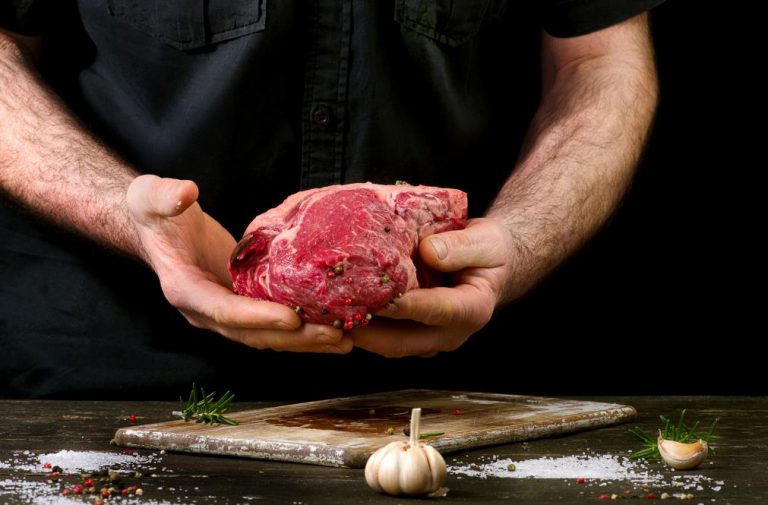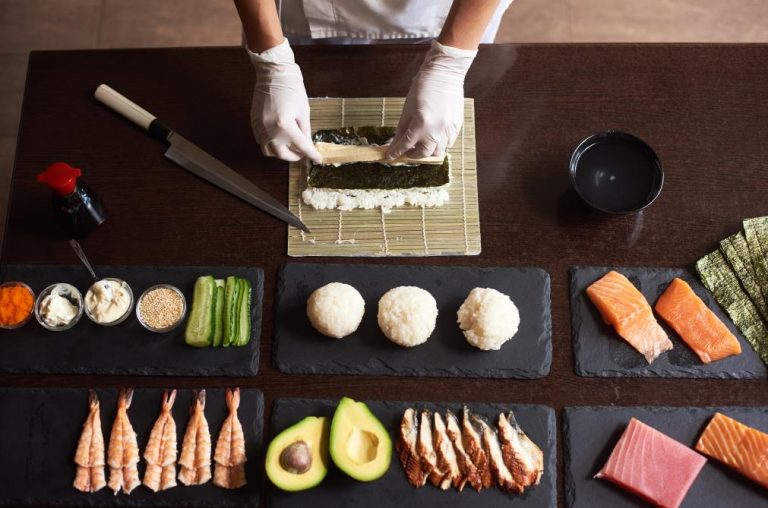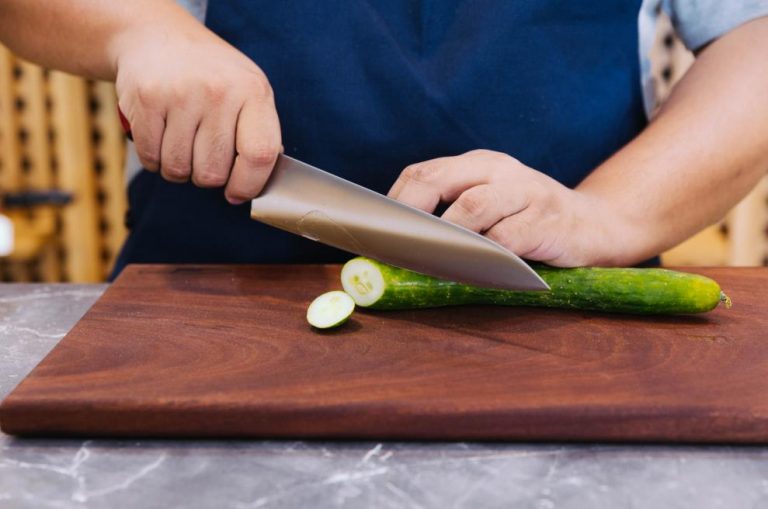In every kitchen, whether amateur or professional and as the foundation knife of any set, the Chef’s knife is the number one global best seller because of its utility and multi – tasking prowess for food prep.
Let’s consider:
- What makes a knife a Chef’s knife?
- What are the different parts of a Chef’s knife?
- How do you use a Chef’s knife and what jobs can a Chef’s knife do?
- What cutting and slicing techniques suit the Chef’s knife best?
- Are there other essential knives I should consider?
- Why should I include Chef’s knives as part of my knife products range for sale?
There are probably knives in your knife collection that you could do without in a pinch. The Chef’s knife is not one of them!
Let’s look at this kitchen stalwart from all angles and learn as we go how very valuable it is to anyone involved in food prep or cookery.
What is a chef’s knife?
Blade characteristics
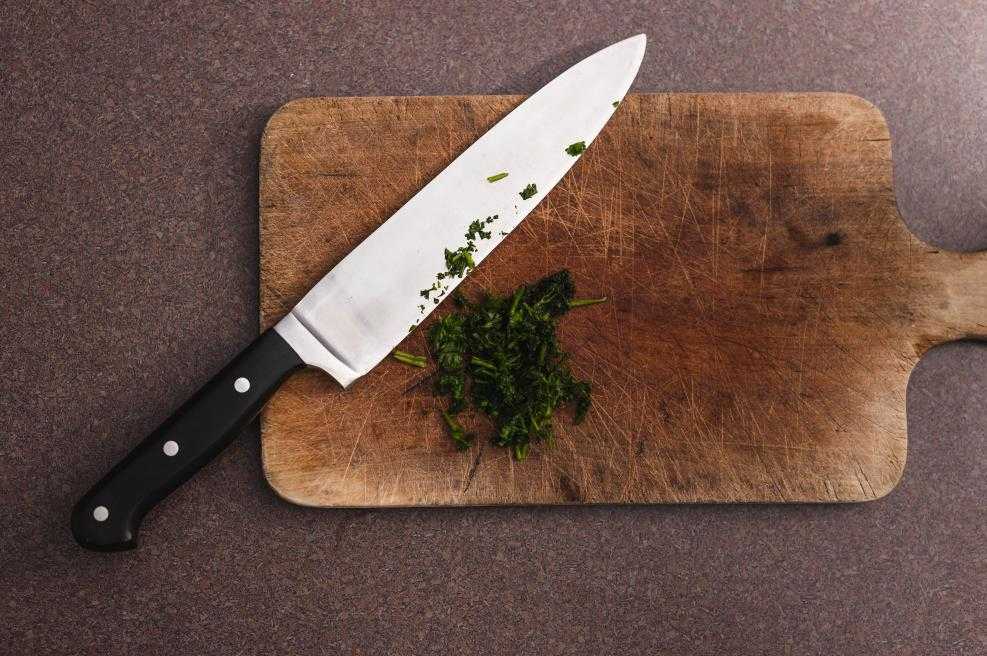
A Chef’s knife is a good – sized knife and that it can have either a flattish blade or a blade with a slightly curved edge or ‘belly’ to it. Its blade is wider at the handle end and tapers thinner towards the tip or end of the blade. The pointed tip allows detail work. A classic chef’s knife normally have a bolster between the knife blade and the knife handle.
A chef’s knife can be serrated with a Granton edge, but this is not standard.
The most common blade length for a Chef’s knife is 8 inches but blades can range from 6 to 14 inches.
Material
A Chef’s knife can be made from a range of materials, the most popular materials today being either stainless or carbon steel.
Handle
As far as a Chef’s knife handles goes, these can be varied in design and material and offer a wide selection based on the vendor and the tastes of the buyer.
Most common to Western tastes is an elongated handle that sits in the hand comfortably and may even have a pinch grip to assist with control.
Buy Wholesale Knives and Start Scaling up with Us Today
Contact us and connect with a sales rep to get a free quote.
What is a chef’s knife used for?
A Chef’s knife is the number one knife in any kitchen simply because it can be used for so many different things. These include:
- Cutting up meats, fish, vegetables, and fruits
- Mincing ingredients like garlic and herbs
- Slicing, chopping, and carving ingredients
- The side of the blade can be used to crush things like garlic or sliced ginger into pastes
- The spine of the blade can be used to scrape ingredients off your cutting board
The Chef’s knife’s value is in its multi – purpose ability to move across tasks in the kitchen from prepping smaller ingredients like carrots right up to slicing larger ingredients like boneless hams.
If you want to look after a Chef’s knife it shouldn’t be used on very tough or high impact jobs like deboning an animal carcass. A heavy Chinese cleaver would be better suited to this task and will prevent the blade of your Chef’s knife being chipped.
How to hold a chef’s knife properly
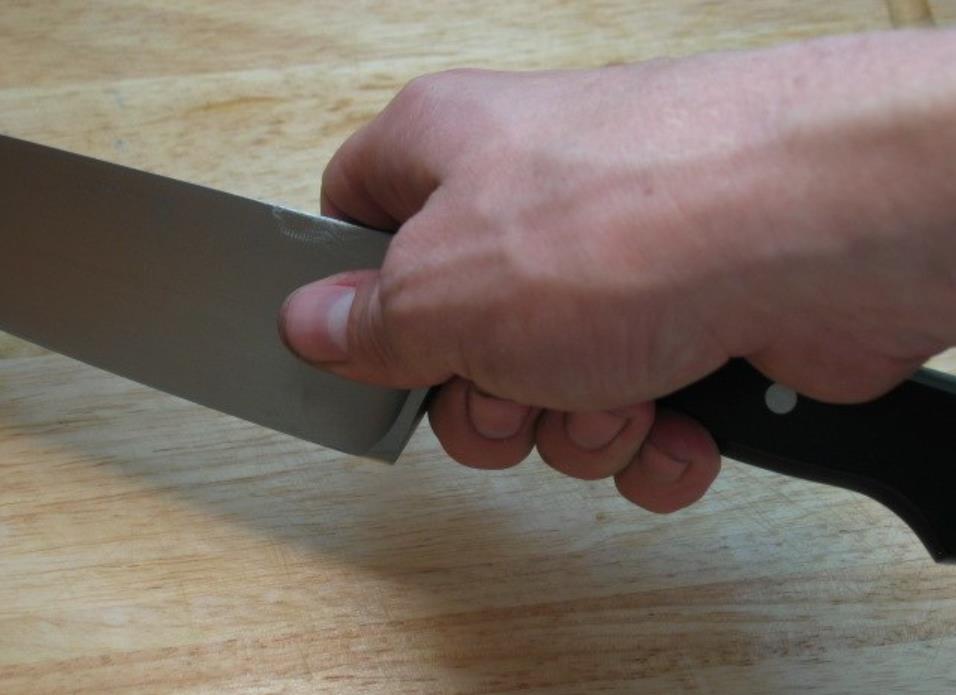
As in the picture above, curl 3 fingers securely around the handle of the Chef’s knife near the heel of the blade. Your thumb and pointer finger hold the top of the blade securely on either side in a pinch grip.
This ‘pinch grip’ technique may need getting used to, but it provides good control and allows you to direct the blade of the knife accurately with minimal effort.
Your other hand (non – knife hand) will be used for securing or holding down the ingredient to cut, with your fingers always positioned or curled up away from the direction that the blade is cutting.
It is important that you take it slow with a Chef’s knife to learn a technique that you’re comfortable with without cutting yourself. Also, a non – slip cutting board is an absolute must to avoid slippage!
Different methods of cutting with a chef’s knife
Slicing
Hold the ingredient to be sliced firmly in your non – knife hand on a stable surface or cutting board, keeping your fingers curled under or placed away from the blade.
Start at one end of the item, and slice through it cleanly moving from one end to the other in even increments. For long items like carrots cuts are usually made across the width of the ingredient. For rounded ingredients like onions cuts are usually made from pole to pole as on a globe.
The wider apart the spaces between cuts are, the thicker your slices will be.
Use the weight of the Chef’s knife to give you downward momentum for a clean and sure downward slice.
Dicing
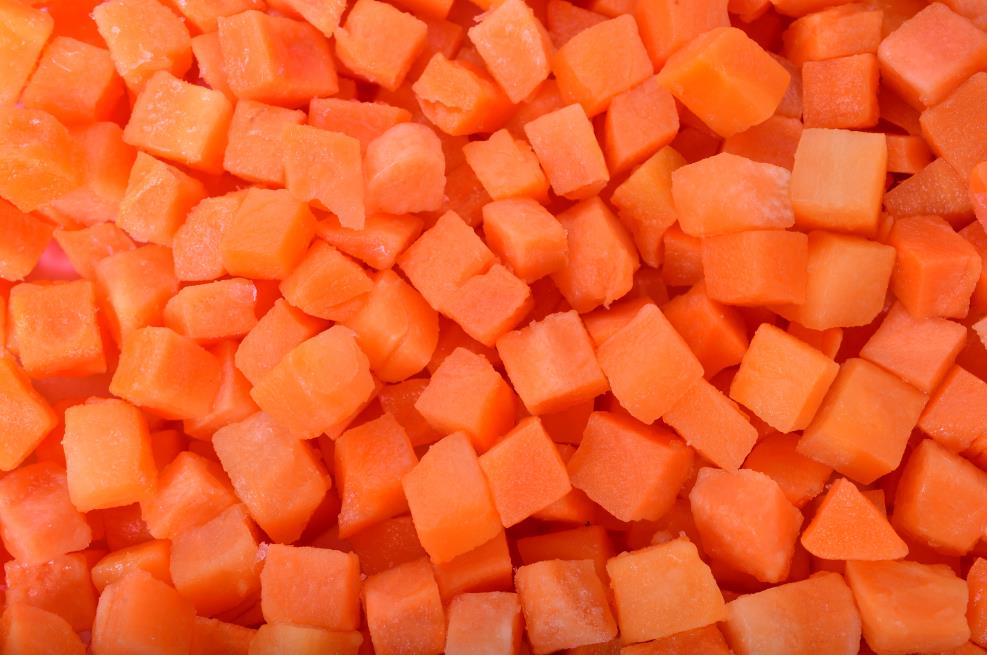
Dicing is simply to use the Chef’s knife to cut slices into small blocks or dice. Position the ingredient you have sliced in front of you and cut the slices across their length several times to reduce it into strips.
Then, place the strips horizontally in a neat pile in front of you, secured with your non – knife fingers, and slice through the pile vertically from one end to the other in small increments. This will result in small cubes of the ingredient being produced.
For dicing a handy technique is to position the tip of the Chef’s knife on the board and move the blade of the knife up and down OR in rocking motion to cut, whichever you find most comfortable.
Mincing
Mincing is to cut ingredients into extremely fine blocks or dice, almost a paste.
To do so, bring together the pieces of ingredient that you want to mince into a tight pile and keeping the tip of the knife on your cutting board, position the blade above the pile. Now move the knife blade up and down on top of and through the ingredient from one side of the pile to the other.
If the pieces are still too large, move the knife up and down through the pile again to reduce the size of the pieces and make them finer. Continue until the ingredient is minced small enough for your liking.
How does a chef’s knife compare to a gyuto knife?
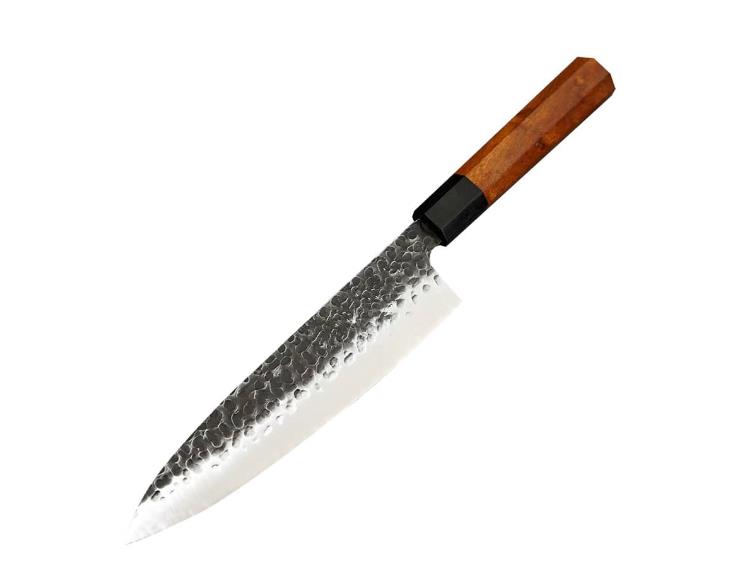
The Japanese Gyuto knife is regarded as the closest Japanese knife (in style) to the Western Chef’s knife, and they are very similar. Let’s see how they compare to each other.
| CATEGORY | CHEF’S KNIFE | GYUTO KNIFE |
| Area of Origin | European | Japanese |
| Blade Length | 6 – 14 inches | 6 – 12 inches |
| Blade Thickness | Thicker blade | Thinner blade |
| Weight | Heavier than Gyuto | Lighter than Chef’s knife |
| Beveling | Double bevel | Usually double, can be single |
| Usage | Multi – purpose | Multi – purpose |
| Originally Designed For | Multi – purpose | Cutting meat |
| Avoid | Large bones, it is not a heavy cleaver | Thin blade can struggle on dense or very hard items |
| Ease of Sharpening | Moderately easy | Sharpening single bevel can be tricky |
| Cutting Motion Used | Up and down or rock chop | Push cutting but can rock chop if belly curved |
As you can see, the Gyuto is called the ‘Japanese Chef’s knife’ for a reason!
There’s a lot of overlap between the two knives, but overall, a Gyuto is lighter and more delicate in construction and can achieve a thinner, finer cut than a Chef’s knife because the blade is thinner.
A Gyuto due to the thinner blade can be used more easily for detail work like garnishes that the bigger and thicker bladed Chef’s knife would struggle with.
Are chef’s knives a good product to carry in a knife store?
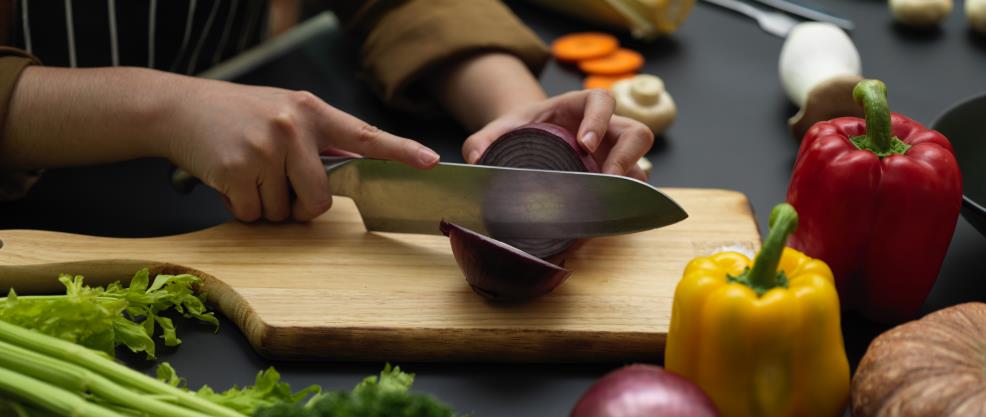
Absolutely! As we’ve said, the chef’s knife is the most widely purchased knife available today and you are virtually guaranteed a ready market for this type of knife.
A chef’s knife because it’s so utilitarian can handle both lighter and more heavy tasks and the double bevel blade makes it easy to use and to sharpen for Western buyers and for cooks from novice to expert level.
If you’re selling into either a home kitchen or a professional kitchen environment, both spaces will have an identifiable need for a good quality, multi – tasking Chef’s knife.
Buy Wholesale Knives and Start Scaling up with Us Today
Contact us and connect with a sales rep to get a free quote.
It’s important to note too that the Chef’s knife is the backbone of the whole knife collection, it does more jobs alone than any other arrangement of knives could do separately. That’s what makes it a sound investment and a tool worth investing in for any cook.
The Chef’s knife is certainly NOT a ‘nice to have’, it’s an absolute essential anywhere that food is prepared.
In conclusion
We’ve had great fun with this overview of the handy and oh so useful Chef’s knife, it’s every kitchen’s workhorse and deserves its place in the sun!
Along with Chef’s knives we offer Western and Eastern style knives of various types and design to tempt any buyer, take a look of the products you’re interested in.
Do visit us again at the LeeKnives blog as we have other articles and resources to help your knife business succeed. Need a quick and friendly quote? We’d love to help you out with that too, so do visit our quote portal.
Thank you for joining us!

